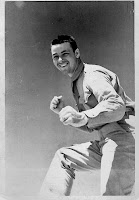Because of their bold displays of light most photographers are drawn to sunsets and sunrises, and rightly so for the most part. What most of them do not realize is that sunsets and sunrises are pretty much considered cliche material in the photography world. They have been photographed so much and so often by just about everyone who owns a camera, that to truly take a unique version of one requires an exceptional array of circumstances and skill.
Even so, there are some do's and don'ts you can apply to your attempts at photographing these amazing moments of light. Let's take a look a few of them.
First of all, one of the biggest mistakes novice photographers make when photographing sunsets or sunrises is to center the sun in the middle of the image and to divide the scene half and half between the sky and ground. Here's a coupe of examples.
 |
| Don't |
In this first picture the sun has risen several points above the horizon. the exposure is not so bad here but the composition of the scene leaves a lot to be desired. With the sun centered the way it is, the interest level drops way off...it's just too symmetrical with not enough variation in the scene nor any central point of interest or reference. To correct an image like this, the sun should be offset to one side and more of terrain included. Something like this:
 |
| Do |
In this image, the composition is much stronger as there is a central point of interest and variation in the scene.
Here's another example of what not to do.
 |
| Don't |
In this image, once again the sun is centered and the composition is spaced half and half between the sky and the ground. Although the fence and barn add a bit of interest, this is not exactly a very good arrangement photographically speaking. To correct an image like this apply the same kind of principle to offset the sun to one side and include more of the sky with just a sliver of landscape at the bottom to provide a sense of scale. The sky is the main ingredient here...so make it your main subject.
 |
| Do |
 |
| Do |
Sunsets can also be taken in the vertical. The vertical or portrait view allows for more sky to be included and works well when there are a lot of textures in the composition. Framing the sunset in the bow of tree is a nice effect and serves to bring attention to the main subject.
Although I still find myself pointing my camera at both sunsets and sunrises I prefer sunrises as they tend to occur when the atmospheric conditions offer a greater variety of conditions. Early morning light offers a great amount of contrasts both subtle and bold...throw in a little fog and you have a great combination. The trick is to not so much focus on the rising sun...but to focus on the effects the light has on the scene. Here's an example of what I'm talking about. In this photo the sun is nowhere to be seen, but you do see the effects of that wonderful morning glow.
 |
| Do |
Sometimes I will turn around and look the other direction during a sunrise. Some of the best light of the day can be found in opposition to where the sun is actually coming up. This photo was taken at sunrise...actually just before the sun broke the horizon. It is looking west toward the setting moon away from the source of the light, and a soft glow was filtering across the farm country. Not long after this image taken, the sun actually did rise and the conditions changed to a more harsh kind of lighting...and my shooting for the morning was over.
Here is another example of looking the other direction, except this time during a sunset. The best light I discovered was behind me...the actual sunset was rather ordinary.
So, as you can see, capturing sunsets and sunrises don't always have to include the typical cliche images. Look at the effects of the light instead of the source and you just might discover some amazing opportunities to capture a unique collection of sunrise and sunset moments.
Keith
 Even so, on our bookshelves sit 8 or 10 old albums of exactly those kinds of images. Most were taken with simple disposable cameras and are not of very good quality, yet they retain a sense of spontaneity that more polished images tend to neglect. More importantly, they possess more personal value than all of the so called higher quality images I've ever taken.
Even so, on our bookshelves sit 8 or 10 old albums of exactly those kinds of images. Most were taken with simple disposable cameras and are not of very good quality, yet they retain a sense of spontaneity that more polished images tend to neglect. More importantly, they possess more personal value than all of the so called higher quality images I've ever taken.













